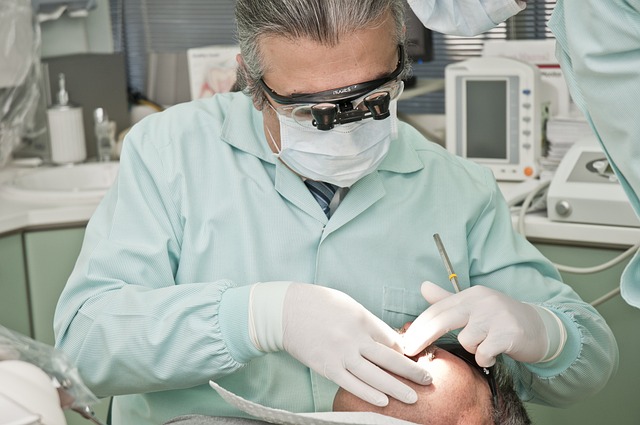When Does Granulation Tissue Form Post Tooth Extraction?
Welcome, dental enthusiasts! Today, we delve into a topic that often puzzles both patients and dentists alike: the formation of granulation tissue following a tooth extraction. We understand that dental procedures can be a source of anxiety, and it’s only natural to be curious about the healing process. Fear not! In this informative article, we will shed light on the chronology of granulation tissue formation, unraveling the mysteries that surround this essential step in your dental recovery. So sit back, relax, and let’s embark on this friendly journey of discovery together!
1. The Healing Process: Understanding the Formation of Granulation Tissue after Tooth Extraction
After a tooth extraction, the healing process is crucial to ensure a healthy recovery. One of the key components of this process is the formation of granulation tissue. This specialized tissue plays a vital role in wound healing and is responsible for filling in the socket left after the tooth is removed. In this section, we will delve into the fascinating world of granulation tissue and understand its importance in the healing journey.
Granulation tissue is made up of new blood vessels, fibroblasts, and inflammatory cells. It is typically reddish in appearance and has a soft, spongy texture. The formation of this tissue begins within 24 to 48 hours after the extraction and progresses over the following weeks. Its development is a natural part of the healing process and is a sign that your body is repairing itself.
- Promotes blood supply: Granulation tissue helps establish a robust blood supply to the healing site, delivering oxygen and nutrients that are essential for the regeneration of tissue.
- Prevents infection: This specialized tissue acts as a protective barrier, preventing bacteria and foreign particles from entering the extraction site and causing infection.
- Aids in tissue repair: Granulation tissue promotes the growth of new cells and supports the formation of new bone and gum tissue, aiding the overall healing process.
Understanding how granulation tissue forms after a tooth extraction is crucial in ensuring proper care and monitoring during the healing process. It is important to remember that while some discomfort and swelling are normal, any excessive pain or prolonged bleeding should be brought to the attention of your dentist or oral surgeon. With proper care, the formation of granulation tissue will contribute to a successful, pain-free recovery.

2. Deeper Insight: What Happens in Your Mouth When Granulation Tissue Begins to Form
Granulation tissue is a crucial part of the healing process that occurs in your mouth after dental surgery or when there is an injury. This specialized tissue forms as a response to injury, inflammation, or infection, and plays a vital role in healing and regenerating damaged tissues. Let’s take a closer look at what happens in your mouth when granulation tissue begins to form:
- Increased blood flow: When an injury occurs, blood vessels in the affected area dilate, allowing more blood to flow to the site. This increased blood flow is essential for delivering oxygen, nutrients, and immune cells to promote the healing process.
- Migration of cells: Various types of cells, such as fibroblasts and endothelial cells, migrate to the injured site. Fibroblasts are responsible for producing collagen, which forms the structural framework of the new tissue. Endothelial cells, on the other hand, help build new blood vessels, a process known as angiogenesis.
- Formation of granulation tissue: As these cells migrate and accumulate in the injured area, they begin producing new connective tissue, referred to as granulation tissue. This tissue is rich in collagen, blood vessels, and inflammatory cells, which work together to repair the damaged area. Granulation tissue is often characterized by its red, bumpy appearance.
Understanding the process of granulation tissue formation gives us an insight into the intricate healing mechanisms that take place in your mouth. It is important to note that proper oral hygiene, gentle care, and following any post-operative instructions provided by your dental professional are essential to support the healing process and ensure optimal recovery.

3. Uncovering the Timeline: When Can You Expect Granulation Tissue to Develop after a Tooth Extraction
After a tooth extraction, the timeline for granulation tissue development is an important factor for patients to understand. While every individual’s healing process may vary, here is a general outline of what you can expect:
The First 24-48 Hours:
- Immediately after the extraction, a blood clot should form in the extracted socket to facilitate healing.
- Within the first day or two, you may experience some minor bleeding as the blood clot stabilizes.
- It’s essential to avoid disturbing the blood clot during this time to prevent complications.
Days 3-7:
- During this period, the initial inflammation and swelling should begin to subside.
- Typically, you may notice the formation of granulation tissue around days 3-5.
- Granulation tissue is a pinkish moist tissue that aids in the healing process by forming a foundation for new blood vessels and connective tissue to develop.
- Be cautious not to disturb the forming tissue while brushing or eating.
Remember, each person’s healing journey is unique, and it’s always best to consult with your dentist or oral surgeon to ensure proper healing and address any concerns you may have.

4. The First Stage of Healing: Recognizing the Signs as Granulation Tissue Forms in the Extraction Site
During a tooth extraction, the body undergoes a remarkable healing process in order to restore the affected area. One of the initial stages of healing involves the formation of granulation tissue at the extraction site. This phase marks the beginning of the tissue regeneration process and it’s important to recognize the signs to ensure proper care and recovery.
Signs of Granulation Tissue Formation:
- Redness and swelling: It is common to observe mild redness and swelling around the extraction site as the body increases blood flow to begin the healing process. This is a normal response and usually subsides within a few days.
- Pinkish tissue appearance: As granulation tissue starts to develop, you may notice a pinkish hue around the extraction site. This new tissue is crucial for wound healing and will gradually replace the initial blood clot formed after the extraction.
- Gum soreness: It’s not uncommon to experience some soreness in the surrounding gums as the granulation tissue forms. This discomfort is typically mild and can be managed with over-the-counter pain relievers or as advised by your dentist.
Understanding and identifying these signs of granulation tissue formation is an essential part of the healing process after a tooth extraction. If you notice any excessive or prolonged symptoms, such as severe pain, persistent bleeding, or signs of infection, it is important to consult your dentist for further evaluation and guidance.

5. Factors that Affect Granulation Tissue Formation: How Your Lifestyle Choices Influence the Healing Process
In order to better understand granulation tissue formation and the factors that can influence its healing process, it is important to take a closer look at the impact of lifestyle choices. These choices can significantly affect the body’s ability to heal and regenerate. By making conscious decisions and adopting healthier habits, one can optimize their healing process and promote the formation of granulation tissue.
1. Diet: A balanced and nutritious diet plays a crucial role in the body’s healing process. Consuming adequate amounts of protein, vitamins, and minerals can help provide the necessary building blocks for granulation tissue formation. Incorporating foods rich in vitamin C, such as citrus fruits, leafy greens, and bell peppers, can support collagen production, a vital component of granulation tissue. Additionally, omega-3 fatty acids found in fish, flaxseeds, and walnuts can help reduce inflammation and accelerate healing.
2. Exercise: Regular physical activity has numerous benefits for overall health, and it can also positively impact granulation tissue formation. Engaging in exercises that stimulate blood circulation, such as walking, swimming, or cycling, can enhance oxygen and nutrient delivery to the wound site. This improved blood flow can promote the development of healthy granulation tissue, leading to faster healing. It is important to consult with a healthcare professional before starting any exercise routine, especially if recovering from a wound or injury.
6. Sore No More: Learn How Granulation Tissue Promotes Pain Relief and Prevents Infections
Granulation tissue is a vital part of the wound healing process that often goes unnoticed. This tissue plays a crucial role in promoting pain relief and preventing infections. So, let’s dive into the fascinating world of granulation tissue and understand why it is a key player when it comes to healing.
Granulation tissue forms in the second stage of wound healing, known as the proliferative phase. Here are some important points to know about granulation tissue:
- Red and bumpy appearance: Granulation tissue is typically characterized by its bright red color and bumpy texture. This is due to the proliferation of new blood vessels, collagen, and inflammatory cells that aid in the wound healing process.
- Role in pain relief: Granulation tissue is rich in nerve endings and growth factors that help alleviate pain. As it forms, it assists in stimulating the surrounding tissues to regenerate, providing a cushioning effect and reducing discomfort.
- Preventing infections: One of the primary functions of granulation tissue is sealing the wound, acting as a barrier against potential pathogens. Its moist environment helps to prevent bacterial invasion, reducing the risk of infections and promoting healing.
- Scar tissue formation: Ultimately, granulation tissue transforms into scar tissue, which completes the wound healing process. Scar tissue may look different from the surrounding skin, but it ensures the wound is closed and protected.
Next time you observe a wound or sore that starts to develop characteristic red and bumpy tissue, remember the importance of granulation tissue in promoting pain relief and preventing infections. It’s fascinating how our bodies have their own remarkable ways of healing!
7. Patience is Key: How Long Does It Take for Granulation Tissue to Fully Form after a Tooth Extraction
After a tooth extraction, it is important to remember that patience is key when it comes to the formation of granulation tissue. This tissue plays a crucial role in the healing process, acting as a foundation for new bone to grow and for a dental implant, if necessary. But how long does it take for granulation tissue to fully form? Let’s explore:
Factors affecting the formation of granulation tissue:
- Each person’s healing process varies, so the time it takes for granulation tissue to fully form can differ.
- The complexity of the extraction, such as the presence of infection or impacted teeth, may impact the time it takes for granulation tissue to develop.
- Oral hygiene practices and adherence to post-operative care instructions can influence the speed of healing.
Typical timeline for granulation tissue formation:
While it is difficult to pinpoint an exact timeframe, it generally takes about 2-4 weeks for granulation tissue to fully form after a tooth extraction. During the first few days, a blood clot forms in the extraction socket to protect the underlying tissue. Within a week, the clot is gradually replaced by granulation tissue as a part of the body’s natural healing process. Over the following weeks, the tissue matures, and new bone begins to develop. Regular follow-up appointments with your dentist will help monitor and ensure proper healing.
8. Keeping a Watchful Eye: Warning Signs of Complications during the Granulation Tissue Formation Phase
During the granulation tissue formation phase, it’s important to keep a watchful eye for any warning signs of complications. While this phase is a crucial part of the wound healing process, certain symptoms may indicate potential problems that require medical attention. Here are some key signs to be aware of:
1. Excessive bleeding: While mild bleeding is normal during the formation of granulation tissue, if you notice persistent or heavy bleeding, it may indicate an underlying issue. Contact your healthcare provider if the bleeding doesn’t subside or if it worsens.
2. Increased pain or swelling: Some discomfort is expected during this phase, but if you experience intensifying pain or swelling around the wound site, it could be a sign of infection or an abnormal healing response. Monitor the pain level and seek medical advice if it becomes severe or unbearable.
3. Strong odor or pus discharge: Granulation tissue should not produce a strong, foul odor or excessive pus. If you notice an unpleasant smell or a significant amount of discharge, it may indicate an infection. You should consult a healthcare professional who can assess the wound and provide appropriate treatment.
4. Delayed healing: Generally, granulation tissue forms within a specific timeframe. If you notice that the wound is not progressing or healing as expected, it might suggest an issue with the healing process. Inform your doctor so they can evaluate the situation and determine the best course of action.
Remember, it’s essential to keep a close eye on the healing wound during the granulation tissue formation phase. By staying vigilant and watching out for these warning signs, you can ensure timely intervention and promote proper wound healing.
9. Speeding up the Healing Process: Tips and Tricks to Encourage Granulation Tissue Formation after Tooth Extraction
After a tooth extraction, proper care and attention can significantly speed up the healing process. One key aspect of successful healing is the formation of granulation tissue, which helps protect the extraction site and promotes tissue regeneration. To encourage granulation tissue formation and minimize discomfort, follow these helpful tips:
- 1. Maintain oral hygiene: Gently brush your teeth, avoiding the extraction site, and rinse your mouth with a saltwater solution to keep bacteria at bay and prevent infection.
- 2. Follow a soft diet: Stick to soft foods like yogurt, mashed potatoes, and soups to avoid putting excessive pressure on the extraction site, allowing granulation tissue to form undisturbed.
- 3. Apply cold packs: To reduce swelling and discomfort, apply a cold pack to your cheek in intervals of 10 minutes on and 10 minutes off during the first 24 hours after extraction.
Furthermore, it is important to avoid smoking or using tobacco products as they can delay the healing process. Additionally, touching the extraction site with your fingers or tongue should be avoided to prevent infection. If you have any concerns or experience prolonged pain or bleeding, don’t hesitate to contact your dentist for professional advice.
10. The Final Stage: What Happens When Granulation Tissue Fully Develops and How Your Dentist Can Assist the Healing
Once the granulation tissue has fully developed, an important phase of healing has been accomplished. This process involves the growth of tiny blood vessels, connective tissue, and collagen, which helps in wound closure and the regeneration of new tissue. During this stage, you may notice that your gum tissue starts to feel firm and less sensitive to touch. It’s a positive sign that your body is healing and returning to its healthy state after dental surgery or an extraction.
To assist in this healing process and ensure a successful recovery, your dentist plays a crucial role. They will carefully monitor your progress and provide guidance to optimize healing. Here are a few ways your dentist can assist you during this final stage of granulation tissue development:
- Regular check-ups: Your dentist will schedule follow-up visits to assess the healing and make any necessary interventions. This ensures any potential issues are caught early on.
- Cleaning and maintenance: Maintaining good oral hygiene is essential for proper healing. Your dentist will show you how to clean around the surgical site and may recommend special mouth rinses or tools to keep the area clean.
- Medication management: If you were prescribed any medication, your dentist will evaluate its effectiveness and make adjustments if needed.
Remember, every individual’s healing process is unique. It’s important to follow your dentist’s instructions and communicate any concerns or changes you may experience during this final stage of granulation tissue development. Before you know it, you’ll be fully healed and ready to confidently enjoy your healthy smile once again!
Frequently Asked Questions
Q: When does granulation tissue typically form post tooth extraction?
A: Granulation tissue commonly begins to form within one to two weeks following a tooth extraction procedure.
Q: What is granulation tissue, and why does it form after a tooth extraction?
A: Granulation tissue is a type of connective tissue that forms during the healing process following a tooth extraction. It is composed of blood vessels, fibroblasts, and collagen, which work together to provide a scaffold for the growth of new tissues.
Q: How does the formation of granulation tissue contribute to the healing process?
A: Granulation tissue plays a vital role in the healing process by promoting the growth of new blood vessels and supporting the development of new bone and soft tissues. It acts as a protective barrier, helping to prevent infection and facilitating the regeneration of healthy tissues.
Q: Are there any symptoms or signs that indicate the presence of granulation tissue?
A: While granulation tissue is typically not visible to the naked eye, it may be accompanied by certain signs such as redness, swelling, or sensitivity around the extraction site. However, it’s important to note that these symptoms can also be indicative of other complications, so it’s best to consult your dentist for an accurate diagnosis.
Q: How long does the presence of granulation tissue last?
A: The duration of granulation tissue varies from person to person, but it usually lasts for a few weeks to a couple of months. The tissue gradually regresses as new bone and connective tissue mature and replace it.
Q: Is it necessary to remove granulation tissue during the healing process?
A: In most cases, there is no need to remove granulation tissue unless it becomes excessive or interferes with the healing process. Your dentist will monitor the healing progress and determine if any intervention is required.
Q: Are there any home remedies or treatments that can help promote the healing of granulation tissue?
A: Maintaining good oral hygiene, including gentle brushing and rinsing with saltwater, can promote the healing of granulation tissue. It’s crucial to follow your dentist’s instructions and attend any follow-up appointments to ensure proper healing.
Q: Are there any complications associated with the formation of granulation tissue?
A: Granulation tissue is a natural part of the healing process and usually does not cause complications. However, in rare cases, excessive or persistent granulation tissue may lead to delayed healing, infection, or gum overgrowth. If you have any concerns, it is advisable to consult your dentist.
Q: Can smoking or certain medications affect the formation of granulation tissue?
A: Yes, smoking and certain medications, such as anticoagulants, may affect the formation and healing of granulation tissue. It is important to inform your dentist of any medications you are taking or lifestyle habits, such as smoking, to ensure proper guidance and optimal healing.
Q: Is it normal to experience discomfort or pain during the formation of granulation tissue?
A: Some discomfort or mild pain during the formation of granulation tissue is normal. However, if you experience severe or persistent pain, it is essential to contact your dentist for further evaluation, as it could indicate an underlying issue.
Conclusion
In conclusion, understanding when granulation tissue forms after a tooth extraction is essential for a successful healing process. Granulation tissue, a crucial component of the initial healing phase, begins to form around three to four days following the procedure. This soft, pink tissue acts as a scaffold for new blood vessels and supports the formation of healthy gum tissue. Although its appearance might seem worrisome, this natural part of the healing process should be embraced and monitored closely. Remember, maintaining good oral hygiene practices and following any post-extraction instructions provided by your dentist will play a significant role in the successful formation of granulation tissue. So, rest assured, dear readers, that as the days pass, your mouth is diligently working to restore itself.






